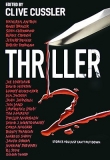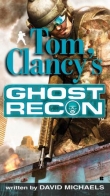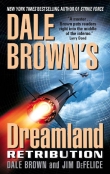
Текст книги "Ghost Fleet: A Novel of the Next World War"
Автор книги: P. Singer
Соавторы: August Cole
Жанр:
Триллеры
сообщить о нарушении
Текущая страница: 33 (всего у книги 37 страниц)
Fifty-Five Miles Northwest of the Zumwalt, Pacific Ocean
The remaining Shrikes climbed steeply up to sixty-five thousand feet and raced toward the coordinates provided by the Orzel. They flew in a tight stack of wedges, each pilotless aircraft programmed to hold itself exactly seventeen inches away from the next. The distance had been chosen by the Shrike software designer after reading that the closest that human pilots would risk was the eighteen inches of distance that Blue Angels pilots put between their planes during their Diamond 360 maneuver. The effect was to blur the drones’ already small radar signatures into one.
Within minutes, the formation crossed the white wakes of the Russian and Chinese surface-ship formation, arced out in a wide curve.
They relayed the image back to the bridge of the Zumwalt.
“Sir, we have a video burst from the flight. They’ve got visuals on the enemy surface task force. Looks like the Puffin missiles took out three of the smaller ships, but four biggies, including the Zheng He, are steaming in our direction at flank speed, fifty-five miles out,” said the tactical officer. “We’re in their missile range now. I’m not sure why they haven’t fired again.”
“They’re likely as low on missile stocks as we are,” said Simmons. “Looks like they’re planning on making it personal, finishing us off with guns.”
“Redirect the drone flight at them?” said the tactical officer.
“No, taking out the enemy’s remaining carriers is more important than even us,” said Simmons. “Proceed as planned.”
The drones flew onward past the surface ships, indifferent to both the tension that this bypass caused the American fleet and the relief it gave to the surface ships below.
Admiral Zheng He Bridge
The shouting on the bridge of the Admiral Zheng He subsided as the aircraft flew on. It had not been visible, but radar had initially picked it up at over thirteen miles overhead. They tried to shoot it out of the sky but it was impossible to get a radar lock. That it had not come in low pointed to its being one of the Americans’ surveillance aircraft, perhaps one of their rumored high-altitude drones. They passed on the information to the aircraft carrier element’s combat air patrol and ordered a pair of fighters to intercept.
A single surveillance plane would confirm the surface screening force’s position to the Americans. But they would also know it didn’t matter. His force was closing in on the remains of the U.S. task force to finish them off. Any kind of follow-up attack from the American mainland would come too late. They were alone, soon to be cut off, and as vulnerable as any enemy commander could hope. It would be an absolute victory, the kind Sun-Tzu had written about but never achieved in his own career.
Wang considered for a moment that perhaps, once his staff reviewed his command footage and records, he should write his own book.
USS Zumwalt, Forward Rail-Gun Turret
It was like being back on one of those road trips, the kids in the back seat of the station wagon constantly asking the same question over and over.
“Damage crew, how much longer?” said Captain Simmons into the radio.
Yet it also nagged the old man that it had taken this kind of moment for him to see his son at his best.
Mike took in the showers of welding sparks raining down onto the crew below decks frantically trying to repair the rail-gun loading mechanism and the power cable connections.
“Twenty minutes,” said Mike.
“You have ten. That battle cruiser mounts one-hundred-thirty-millimeter main guns with a fifteen-mile range. You taught me boxing, so you know that I need that rail gun to be punching at them before we get inside their swing.”
“If we’re going to fight the rail gun, Vern says we really are going to need to power down the bilge and auxiliary pumps. We can’t do that, sir, not now. This ship wasn’t designed to take hits. Big, top-heavy design like this, we risk taking on too much water and we’ll roll.”
“Chief, I understand. Just focus on your job and I’ll do mine.”
The little bastard is even starting to talk like me, thought Mike.
USS Zumwalt Ship Mission Center
The display on the far wall showed the rail-gun turret free of the debris, but then a spray of sparks shot out from one of the holes punched in the deck. Out leaped Brooks; his work overalls were already singed at the legs, and now they were blackened about the shoulders. He was literally smoking. He threw an acetylene cutting torch down on the deck and cursed, first at the malfunctioning tool, then at the hole in the ship, and then at something in the distance, evidently the enemy fleet. Then the young sailor picked up the tool and went back into the hole. In that action, Jamie saw his father’s influence.
“Sir, we’ve got a contact burning through the jamming. It must be close,” Richter at the radar station said. “Yes, I have the enemy task force at forty miles out. Four ships, one capital-ship size. That must be the Zheng He.”
The rail-gun turret tried again to swivel, but it just shook back and forth like a muzzled dog. Sneaking peeks up from their workstations, the crew whispered, getting visibly anxious.
Simmons cued his headset again, leaning forward to get a better look. “Damage control, how much longer is it going to take?”
“Jamie, I am not trying to assemble your goddamn bicycle on Christmas Eve! Just leave us alone and we’ll get it fixed,” said Mike.
A few of the crew stifled laughs as the conversation played out on the room’s speakers. Simmons grimaced in exasperation and shook his head, throwing the headset at the deck.
“Radar’s picked them up, sir. Thirty-nine miles now,” said Richter. “I’m guessing they’ve developed the same tactical picture we have. They’re now closing directly at us at flank speed.”
138 Miles Northwest of the Zumwalt, Pacific Ocean
The two Chinese J-31 fighter jets from the task force’s combat air patrol elevated to follow the incoming target and then went to afterburner to close for a firing solution.
The pilots were angry. They hadn’t been sent on the strike mission against the enemy fleet, which had most likely kept them from dying, but it left them furious at their impotence, all the more so when their wing mates didn’t return. And now, twenty thousand feet below, the Liaoning, the carrier they had launched from, their home for the last two years, had smoke spilling out of its stern. A submarine had somehow snuck close enough to fire off a torpedo before the destroyer escort had sunk it. They had been bystanders yet again, powerless against an attack that had left their home listing badly to starboard. They were unsure if they would be able to land on it at the end of their patrol or if they would have to divert to one of the other carriers. That was a question to be answered later, though. Now, at least they could vent their fury on the American drone.
The lead pilot radioed that the radar signature of the surveillance drone coming in above them at seventy-seven thousand feet was strange. It didn’t fit any profile in the recognition software, which conformed with the report from the surface-fleet element. He fired a long-range PL-12 air-to-air missile at it, and then a second one, just for good measure.
Moments later, there was an explosion above in the distance, followed by another. And yet the radar signature stayed on his screen. Still climbing altitude to close for visual range, his wing mate firing off a PL-10 short-range heat-seeking missile as added insurance.
As the fighter jets reached their maximum altitude of sixty thousand feet, they saw what looked like the silhouette of an arrowhead falling from the sky, a triangular drone of some sort diving back down to their level. At sixty-two thousand feet, when the third missile reached the target, its proximity warhead exploded a spray of metal shrapnel a mere hundred feet away. The arrowhead was clearly hit, showing a burst of orange flame and then smoke trailing as it fell toward them.
Yet as the arrowhead passed by them, the damaged drone seemed to shed a layer; a smoking plane peeled off. The rest of the triangular drone continued to dive at maximum speed at the task force below. As the two pilots pushed their fighter jets down to follow, straining against the g-forces as they lost altitude, their threat warnings began sound. Somehow in the midst of its steep dive, the drone below had fired off six Sidewinder missiles, which turned and raced back up at them. They attempted to pull out, but it was too late.
The air-defense systems on the ships below tried to pick up a radar lock, but while the fighter pilots had had a silhouette view of the drones, the systems were faced with only thin, sixteen-inch wing edges coated with radar-absorbent material. At thirty thousand feet, a firing solution finally crystalized, but just as the system locked, the target seemed to dissolve. The Shrike drones spread out from one another, a closed network among them sharing a targeting algorithm that ensured they did not all select the same destination point. Lookouts on the ships began to visually pick out what looked like seven thin lines falling down toward them. At twenty-three thousand feet, one of the lines disappeared in an explosion, hit by a rising air-defense missile.
When the drones were at twenty thousand feet, the task force’s machine cannon opened up, and their tracer bullets tried to connect with six thin, sixteen-inch wedges from miles away. The drones maxed their power, creating sonic booms that fell behind them as they accelerated well past the speed of sound.
Another drone was hit at a range of six thousand feet, leaving the five remaining Shrikes to reapportion their targets in the final seconds of their terminal fall. Flying down at maximum speed from almost directly overhead, an arrowhead slammed into the flight deck of each of the two undamaged carriers. The speed of the dive combined with the drone’s mass drove each robotic kamikaze deep into the bowels of the ship. From five decks below, fiery explosions shot out through the gaping holes they had left. Then the explosions traveled across the length of the carriers, turning them into massive fireballs.
The listing Liaoning turned out to be the lucky one. The remaining Shrike hit its flight deck at an angle. It punched straight through the tilted flight deck and then went out through the hangar deck and into the sea below. The drone felt no disappointment at its failure to completely sink its target, just as its wing mates felt no pride at their success.
USS Zumwalt Ship Mission Center
“Sir, Port Royal is requesting to be released from escort duty so it can advance on the enemy force.”
“Permission denied. That battle cruiser’s main gun range is two miles longer than the Port Royal’s gun. They’ll just stand off and pound the Port Royal, especially at that reduced speed. You heard the old man on the radio. Let’s give him a little more time before we play the martyr,” said Simmons, sounding confident for the crew but inside hoping he was right to trust his father.
“Range is now twenty-eight miles,” said Richter, tracking the four ships of the enemy surface task force in, since the two fleets were now too close for radar jamming to be effective. When the ships were roughly thirteen miles away, they would come into visual range and her job would become redundant.
“Are they following the amphibs?” Simmons had ordered the transport ships in the task force to position themselves where they could support the troops ashore but were as distant as possible from the brewing battle between the surface ships.
“No, sir. Still steaming toward us,” said Cortez. “They want to finish this.”
“So do we,” said Captain Simmons.
USS Zumwalt, Forward Rail-Gun Turret
Vern dried her palm on her pant leg again and then picked up the plastic soldering gun by its greasy handle. This was the last section of wiring to lock back down, which she was thankful for because she could not take any more of the smoke, the smell, and the confinement inside the rail-gun turret. As for the fear, she had long since set that aside, balled it up somewhere next to the nausea in her stomach.
“Almost there,” she said, knowing that Mike was less than a foot from her and could see it just as well. The radio on his tool harness squawked and she heard the captain’s voice.
“All right, damage control. Time’s up. Clear out.”
Vern pulled the trigger on the soldering gun again and ran it smoothly over the surface of the insulated coupling for the rail gun’s high power line; the plastic of the fitting liquefied and melded together.
She heard Mike curse under his breath. He cleared his throat and keyed the microphone with an aggressive click: “Zumwalt Actual, we need one more minute. That’s all. Vern’s literally down to the last wires here.”
“If he doesn’t give us more time, we’re going to get a cold weld. It’s not going to fully fuse, and the bond might snap right at the seam line if it gets any added force on it,” Vern said.
“Damage control, repeat, clear decks, copy!” said the captain.
“When I say we’re almost there, you know damn well I mean it,” said Mike. “Hold for just one minute. Do you copy?”
Klaxon horns sounded an alert across the ship.
“All hands, this is the captain, clear decks; rail-gun battery preparing to fire. Powering down main systems.”
Vern looked up at Mike and then went back to soldering, a wisp rising from the soldering gun’s hot tip. Mike grabbed her around the waist and carried her out of the turret and through two hatches. At last, he set her on her feet.
“Your son is really a pain in the ass. Where did he get that from?” said Vern, wiping the sweat from her glasses with the inside of one of her pants pockets.
“No idea at all.” Mike shook his head as he caught his breath.
The red wash of the auxiliary lighting gave the hallway a surreal glow. They leaned against the bulkhead next to each other and waited.
Then the lighting in the hallway darkened as the power system began to transfer. In the pitch-black, Vern felt a rough hand reach to hold hers. She squeezed it.
There was a crack from the rail-gun turret above. But it was not the triumphant sound of one of the rounds being propelled toward a target. It was the terse clap of an electrical problem. The auxiliary lights went dark and then turned back on with a series of disconcerting strobelike pulses.
Mike felt Vern’s hand slip from his grasp as she started down the hallway, running back toward the turret.
USS Zumwalt Ship Mission Center
“Sir, we’ve got power failures across the ship. Engineering reports engines not powering up. The misfire caused some kind of surge,” said Cortez.
Simmons stared at the systems feed, and he could feel everyone in the cavernous room looking up to see how he would respond. He kept his face blank and set his jaw. Inside, though, he cursed himself, hearing his dad’s voice in his head. If he’d just shown a little patience and listened, they would already be engaging the enemy fleet.
“We can worry about the engines later. ETA to get the gun back online?” said Simmons.
“Don’t know, sir. The chief and Dr. Li are already back in the turret, working the problem again,” said Cortez.
“Range to the enemy?” asked Simmons.
“Twenty-one miles,” Richter responded. On one screen, ATHENA mapped out estimated locations of the enemy task force based on their jamming emissions and radar sweeps of the area. A second screen showed the status of the Z’s weapons systems; a red sphere over the rail gun indicated it was offline.
“Get me Port Royal,” Simmons said.
Captain Anderson appeared on the screen, replacing the weapons-systems view.
“Captain Anderson, bad news, our main gun is still offline and we’ve got engine power loss. We’re not going to be able to contribute to the fight the way we planned. But we’re still going to play our part. As the larger target, we’re the one they’re going to focus their fires on. I want you to position the Port Royal and the America behind us to ensure that. When they open up, that’s when I want you to make your attack run. There’ll hopefully be enough smoke and confusion from what’s happening to us to get you in range.”
“Understood,” said Anderson. “We’ll do our best to make them pay.”
“Thank you. It’s been an honor. Zumwalt out.”
Simmons turned back to Cortez. “Damage-control parties standing by?”
Cortez nodded and offered Simmons a stim tab from his uniform’s breast pocket. “Last one,” said the XO.
Simmons tore open the foil with his teeth and began to chew the gum, eyes fixed on the monitors. He tried to ignore the lost looks that more than a few of the youngest sailors had as they snuck peeks up at the main screens, which were back to showing the tactical map and weapons-systems status, all glowing red.
“Two minutes until the enemy has us within range,” said Richter, her voice steady, professional.
Then the red sphere representing the rail gun pulsed green.
“Rail gun back online! Updating the targeting solution,” said the tactical action officer. A cheer went up in the room and the crew leaned into their workstations.
Mike’s voice echoed through the two-story-high room.
“Bridge, we’ve got the fix, and the rail gun is ready. It’s an ugly solution here in the turret, but it should work.”
Jamie cued up the line to his father.
“Did you say here in the turret?”
“That’s affirmative.” His father’s voice sounded softer than he’d ever heard it.
“Damn it, Dad, what are you doing in there? Clear out! We have to fire now. We’re sitting ducks.”
“Jamie, the power coupling won’t stay in without a little help. The impact shook loose the mountings and cracked the last repair job we did even wider. We’ve patched it again,” said Mike. “But the thing is… just another weld on a gap like that isn’t going to hold unless we get at least another half hour at it. Vern and I are kind of wedging the power line into the coupling so that the heat will fuse the plastic of the fitting fully this time.”
“What heat? You mean the heat from the rail gun firing? That won’t work; we can’t fire it with you in there.”
“Yes, Jamie, you can and you will. Vern and I understand the consequences,” said Mike. “You know what you have to do.”
“Thirty seconds until enemy contact,” said the tactical action officer, focused on his task, paying no attention to the conversation behind him. “ATHENA’s targeting solution is online. Ready for rail-gun release on your order, sir.”
“Jamie, just take care of those kids. Be there for them. Be better than me,” said Mike. The channel went quiet.
After a second of silence, Cortez cleared his throat. “Sir, we have to act,” he said, eyeing his captain with concern. “If it’s needed, I can take over, sir.”
Simmons blinked away tears and spoke.
“Battery release… do it. Fire the rail gun.”
Admiral Zheng He
Water from the spray over the bow soaked his uniform jacket as the flagship cut through the water at almost thirty knots, the rest of task force arrayed behind it.
Wang knew he should be waiting calmly in his ready room, but his blood was up. It was not just the stims; it was the moment. On deck was where a sailor should be, especially for a fight that was ending like this. It was also the kind of image his sailors needed to see. Their fleet had felt the sting, but now they would gain their revenge and taste victory, all the more sweet up close.
Beside him, one of the main 130 mm gun turrets began to swivel, its turn aligning the barrel with the enemy’s largest ship. The ship was not yet visible in the distance, but small plumes of smoke indicated it lay directly ahead.
Wang took the groan of the gun turret moving as his signal to go back to the bridge. He turned quickly, not wanting to wait anymore, and the next thing he knew, he was splayed out on the slick deck, flat on his back. Of all the times to slip and fall.
His aide helped him up with the care he would show a withered old woman who’d fallen while feeding pigeons in the park.
Wang nodded his thanks and took the stairs up to the bridge, aggressively, fast, two at a time, to show them he was not such an old man as they thought. His left knee cried out with every step as his aide rushed to keep pace behind him.
On the bridge, the tactical map was projected into the center of the room; the sailors went silent when the admiral entered. He wondered if they had seen him fall. No matter – the moment would be forgotten amid the glory.
The hologram showed the American task force, blue icons indicating each one’s suspected class, name, and status. What was more important, though, was the parallel series of dotted red lines that steadily drew ever closer to the blue. The lines represented the targeting envelopes of the various weapons in the force; the Zheng He’s main battery of 130 mm guns were the closest red line to the American fleet. All that was needed was for the red line to cross the blue icon of their primary target.
He stood before the screen, not engaged in his usual contemplative pacing but instead trying to take the weight off his aching knee. He willed the line closer so that this would all be over sooner.
There!
“In range, sir, on your orders, we are ready to engage,” said his aide. He held up the tablet screen, ready for Wang to press the icon to clear all ships to fire.
Wang extended his trigger finger and then paused, holding it in the air six inches from the screen. It sounded like a freight train was racing right past the bridge. The very steel of the superstructure seemed to vibrate, tickling the soles of his boots. A giant splash erupted on the port side of the Admiral Zheng He, the water spray rising higher than the ship itself. A few seconds later, another erupted to the starboard side, sending water hundreds of feet in the air in a sharp fantail of white and blue.
He felt rivulets of sweat track their way down his back, and then chastised himself, whispering, “ ‘Pretend to be weak, that he may grow arrogant.’ ”
He jabbed his finger down, but it never touched the screen. The rail-gun round entered the Admiral Zheng He’s superstructure approximately thirty feet beneath where Admiral Wang stood. The strike transferred its kinetic energy with such force that the metal superstructure was literally peeled apart as the round plowed through. The ensuing explosion amidships sent a ball of flame hundreds of feet into the air as the ship’s hull cracked in two.

![Книга [Magazine 1966-07] - The Ghost Riders Affair автора Harry Whittington](http://itexts.net/files/books/110/oblozhka-knigi-magazine-1966-07-the-ghost-riders-affair-199012.jpg)






